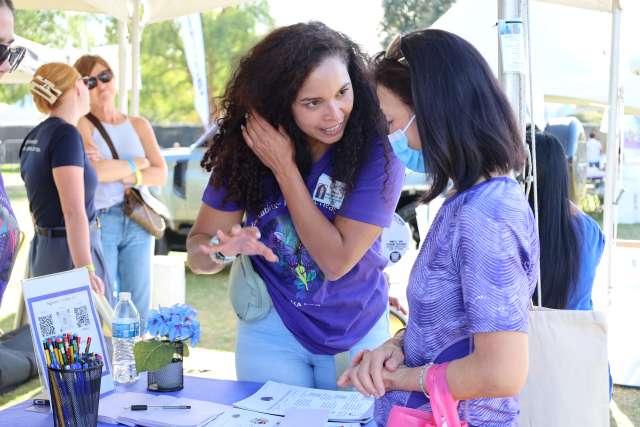While working as an investigator in a biomarkers-in-healthy-aging study prior to the start of the COVID-19 pandemic, UCLA Health assistant professor Mirella Díaz-Santos, PhD had a question burning in her mind.
The study appeared to have all the right pieces meant to engage and recruit a diverse group of participants from Latino communities – a population that research has shown have historically been omitted from such studies.
In this case, participants in the study received a stipend for their time; researchers had made efforts to recruit community members; and residents had responded despite the all-day time commitment.
But a key question remained:
“My question was, ‘Why was the research protocol only in English?’” Dr. Díaz-Santos said.
As the founder and director of the Equity for Latinx-Hispanic Healthy Aging Lab at the Mary S. Easton Center for Alzheimer’s Research and Care at UCLA, Díaz-Santos said the incident was one example of a larger issue in her field that her lab is working to solve.
While Díaz-Santos said there have been earnest efforts to increase diversity of participants in brain health research in recent years, critical reviews have shown the evidence in cognitive science has largely been limited to white, economically advantaged populations who are highly educated. Díaz-Santos said findings from these studies are then applied across cultures without considering or measuring how non-cognitive factors such as history, experience, diet, socioeconomic status and values can influence brain health.
The result is an incomplete understanding of cognitive health across communities, calling into question the validity and generalizability of the interpretations of these studies, Díaz-Santos said.
Building a new research structure
After more than two years of development, Díaz-Santos and academic colleagues recently published a report in the Archives of Clinical Neuropsychology journal outlining a new research framework. The framework, “Re-engaging Individuals and Societies for Structural Evolution,” or “RISE,” has researchers taking a significantly more proactive approach to engage with and incorporate the experiences and histories of racially and ethnically diverse communities in their studies.
The RISE framework is presented in the report through the lens of researchers working with Latino communities. But Díaz-Santos said it can be used across many different cultures and communities.
“If our intentionality and purpose is brain health equity it means that we as a field need to have this collective paradigm shift on how we do research,” Díaz-Santos said. “Rather than engaging community stakeholders when you need something, you need to have the partnership from the beginning.”
The framework represents the foundation of Díaz-Santos’ lab. She founded the lab in 2021 amid the COVID-19 pandemic and increased national attention to racial discrimination.
“People started talking about structural racism in a more open way,” Díaz-Santos said. “The conversations about how these lived experiences impact your brain and disproportionately increase the risk for neurological conditions started flourishing more."
Latinos living in the U.S., for example, are 1.5 times more likely to develop Alzheimer’s disease compared to their white counterparts, according to the Alzheimer’s Association. However, they represent only a small portion of research participants.
Among the roadblocks faced by the Latino population when it comes to participating in research are a language barrier with the researcher or research materials; loss of wages; lack of resources; confidentiality concerns; residency status; lack of health insurance; cost impacts; negative interactions with the research institution; and mistrust of how the data will be used.
What can be done?
Rather than blaming the community for not participating in these studies, Díaz-Santos said the RISE framework calls for researchers to end the “top-down” approach.
“That's the difference between traditional research and research that is more community-centered, where you are always at the table with the same power and there is mutual bidirectional learning to ensure you’re not excluding community members you're trying to engage, recruit and retain,” Díaz-Santos said.
To achieve this, the framework states researchers must work with minoritized communities from the conception of a study through the analysis.
Díaz-Santos said investigators must learn about the history and lived experiences of the population they’re studying in order to provide greater context for their research. This can be achieved both through having a greater diversity of researchers, which has been shown to aid in recruiting a more diverse participant group, as well as through the creation of advisory boards made up of community members.
Additionally, Díaz-Santos and her colleagues call on researchers to examine their own beliefs and judgements during the research process.
Some of the solutions to these impediments may require more institutional-level changes, such as how the National Institutes of Health allocates federal grant funding. Díaz-Santos said there is typically only enough funding provided to a research project for one person to handle community engagement, which can lead to burnout.
“We need guidelines for all the reviewers to pay attention to the budget,” Díaz-Santos said. “How much money are they allocating for community engagement, for building up a community advisory board, for example?”
The framework also provides guidance on how non-cognitive factors affecting brain health could be examined by researchers as part of their studies, including identifying those that may require additional research. Some of these factors Díaz-Santos said should be explored include participants’ migration history, socioeconomic status, cultural lifestyle practices, exposure to environmental hazards, education, neighborhood of residence and health literacy, among others.
Overall, Díaz-Santos and her colleagues said the paper provides greater exposure to the field of community neuropsychology and brings the conversation of brain health equity to the forefront.
“When we talk about brain health equity all the communities have to be equitably engaged, and equity means we will have to invest more in communities that have been disproportionately oppressed by different systems,” Díaz-Santos said.
Will Houston is the author of this article.



